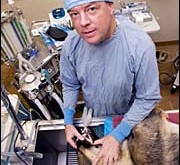Pet Tips
Dogs Cats and Anesthesia – Pet tip 239

Most cats and dogs undergo some type of surgery that requires anesthesia during their lifetimes even if it is only the surgery done for spaying and neutering. Other common procedures that require anesthesia include dental cleaning or dental surgery as well as repairing broken bones. Whenever surgery is done on a pet the topic of anesthesia arises. For the purposes of this article we will be talking about general anesthesia where pets are completely unconscious. We’ve all heard about the potential risks and possible complications regarding anesthesia in our own lives, and so it makes good sense to wonder about anesthetic complications when it comes to our pets as well.
Luckily, veterinary medicine has made huge strides in reducing anesthetic complications. So long as the pet is properly monitored during the actual surgery and the pet has been carefully prescreened for possible problems, anesthesia on pets is quite safe and problems are few. This prescreening should include blood and urine analysis as well as a full physical exam. You also want to make sure your vet knows your pet’s medical history and is familiar with past health problems. Certain past health problems like kidney disease, liver disease, heart disease, asthma etc. will dictate the type of anesthesia to be used. Failure to recognize these health problems and choosing the wrong anesthetic can have disastrous results.
What type of anesthetic will be used depends on the procedure. The two main methods of administering anesthesia are through an injection or through inhaled gas. Your veterinarian will decide which is most appropriate and sometimes will use both methods in the same operation. Often the vet will start off by administering an injection which calms the animal down and then the inhaled anesthetic will be used; it really depends on the procedure. In terms of recovery from the anesthetic, so long as your pet is being monitored by your vet or a vet technician, there should be no problems. This monitoring must be done until the pet wakes up from the anesthetic. The monitoring needs to be continued by the pet owner when the pet goes home.
Once your pet has recovered enough to be sent home it is important to watch your pet for a few days after the surgery. Make sure you ask your vet if there are any post-operative potential side effects you should watch out for. Both the surgery as well as the anesthetic that was used requires that your pet relax for a few days. Limit the amount of exercise for the first few days and keep a close eye on your pet. Although most pets will be fine, call your vet immediately if you notice anything suspicious about the post-operative health or behaviour of your pet.
